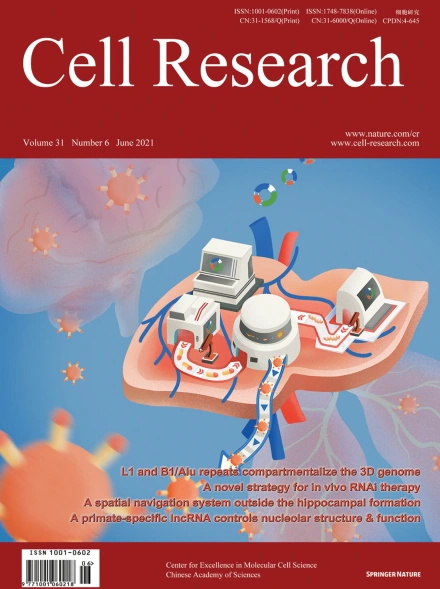
Advanced Search
Submit Manuscript
Advanced Search
Submit Manuscript
Volume 31, No 6, Jun 2021
ISSN: 1001-0602
EISSN: 1748-7838 2018
impact factor 17.848*
(Clarivate Analytics, 2019)
Volume 31 Issue 6, June 2021: 664-683 |
Mutual dependency between lncRNA LETN and protein NPM1 in controlling the nucleolar structure and functions sustaining cell proliferation
Xianteng Wang1,2,3 , Xiaolin Hu1,2,3,4 , Wanlu Song1,2,3 , Hui Xu1,2,3 , Zhengtao Xiao1,2,3 , Rongyao Huang1,2,3 , Qingran Bai5 , Fan Zhang1,2,3 , Yongzhen Chen1,2,3 , Yu Liu1,2,3 , Jianhuo Fang1,2,3 , Xin Li1,2,3 , Qin Shen5 , Haitao Zhao6 , Xuerui Yang1,2,3,*
1MOE Key Laboratory of Bioinformatics, Tsinghua University, Beijing 100084, ChinaFundamental processes such as ribosomal RNA synthesis and chromatin remodeling take place in the nucleolus, which is hyperactive in fast-proliferating cells. The sophisticated regulatory mechanism underlying the dynamic nucleolar structure and functions is yet to be fully explored. The present study uncovers the mutual functional dependency between a previously uncharacterized human long non-coding RNA, which we renamed LETN, and a key nucleolar protein, NPM1. Specifically, being upregulated in multiple types of cancer, LETN resides in the nucleolus via direct binding with NPM1. LETN plays a critical role in facilitating the formation of NPM1 pentamers, which are essential building blocks of the nucleolar granular component and control the nucleolar functions. Repression of LETN or NPM1 led to similar and profound changes of the nucleolar morphology and arrest of the nucleolar functions, which led to proliferation inhibition of human cancer cells and neural progenitor cells. Interestingly, this inter-dependency between LETN and NPM1 is associated with the evolutionarily new variations of NPM1 and the coincidental emergence of LETN in higher primates. We propose that this human-specific protein–lncRNA axis renders an additional yet critical layer of regulation with high physiological relevance in both cancerous and normal developmental processes that require hyperactive nucleoli.
https://doi.org/10.1038/s41422-020-00458-6